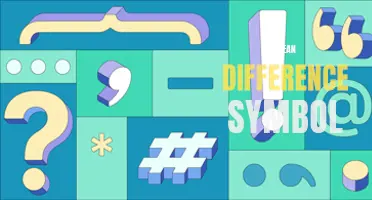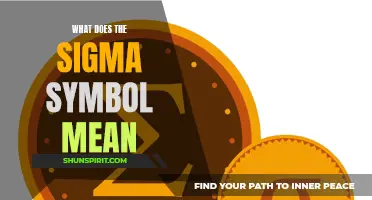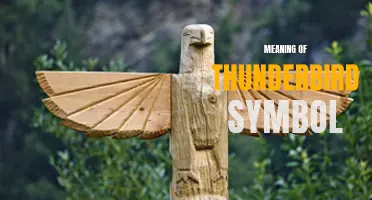
The symbol of a unicorn has captured the imaginations of people for centuries, representing a mystical and elusive creature that embodies beauty, purity, and strength. From ancient mythology to modern culture, the unicorn symbolizes extraordinary power, enchantment, and the pursuit of the impossible. Whether seen as a mythical being or a metaphorical concept, the unicorn continues to fascinate and inspire us with its magical presence. In this article, we will explore the deep-rooted meaning behind the unicorn symbol and uncover the ways it has ingrained itself in human history and consciousness.
What You'll Learn
- What is the cultural and historical significance of the unicorn symbol?
- How has the meaning of the unicorn symbol evolved over time?
- How is the unicorn symbol interpreted in different mythologies and religions?
- What does the unicorn symbol represent in popular culture and modern society?
- Are there any particular societies or groups that hold a special reverence for the unicorn symbol?

What is the cultural and historical significance of the unicorn symbol?
The unicorn is a mythical creature that has been depicted in various forms throughout history and across different cultures. It is often described as a horse-like creature with a single horn protruding from its forehead. The concept of the unicorn has captured the imagination of people for centuries, and it holds significant cultural and historical significance.
In many cultures, the unicorn symbolizes purity, grace, and strength. Its horn, which is believed to possess magical properties, has been associated with healing and protection. The unicorn is often portrayed as a guardian or a bringer of good fortune. In ancient Greece, for example, the unicorn was considered a symbol of purity and was often depicted in sculptures and paintings. It was believed that the touch of a unicorn's horn could purify water and heal sickness.
In European folklore, the unicorn symbolizes strength and courage. It was often depicted as a fierce creature that could only be tamed by a virgin. The unicorn's image was commonly used in heraldry and coat of arms, signifying nobility and virtue. It was also believed that the unicorn's horn had the power to neutralize poisons, making it a valuable object in medieval times.
The unicorn has also been associated with Christianity. In medieval Christian art, the unicorn was often used to represent Christ. The belief in the existence of unicorns was supported by biblical references, such as the description of a "unicorn" in the Book of Job. The unicorn was seen as a symbol of purity and virginity, and its sacrifice was believed to represent the crucifixion of Christ.
In recent years, the unicorn has experienced a resurgence in popular culture, becoming a symbol of positivity and uniqueness. The unicorn's image has been widely used in fashion, art, and marketing, representing a sense of whimsy and magic. It has also become a symbol of empowerment, especially for young girls and women, as it embodies strength and individuality.
The cultural and historical significance of the unicorn symbol cannot be overstated. Its image has been passed down through generations, captivating people's imaginations and inspiring a sense of wonder. Whether seen as a mystical creature, a symbol of purity, or an emblem of strength, the unicorn continues to hold a special place in human culture. Its enduring popularity and timeless appeal are a testament to the power of mythology and the enduring impact of symbols.
The Intriguing Symbolism Behind the Corvette Logo: Exploring its Hidden Meanings
You may want to see also

How has the meaning of the unicorn symbol evolved over time?
The unicorn symbol has a long history that spans across different cultures and time periods. This mythical creature has captivated the imagination of humans for centuries, and its meaning has evolved over time. From being a symbol of purity and grace to representing power and fantasy, the unicorn has garnered different interpretations and significance throughout history.
In ancient times, the unicorn was often associated with purity and innocence. It was believed that only a virgin could capture a unicorn, and its horn had the ability to purify water and heal ailments. These associations with purity and healing made the unicorn a symbol of divinity and goodness.
During the Middle Ages, the unicorn became a prominent symbol in Christian mythology. It was often depicted as a Christ-like creature that could only be tamed by a virgin. The unicorn's horn, known as the alicorn, was believed to have magical properties, such as the ability to detect and neutralize poisons. The unicorn came to represent virtue and purity in Christian art and literature.
In the Renaissance period, the unicorn took on a more secular and symbolic meaning. It became a symbol of power and royalty, often depicted in tapestries and coats of arms. The unicorn was seen as a creature of strength and dominance, representing the power of kings and queens. This shift in meaning was influenced by the growing interest in science and exploration during this time.
In recent centuries, the unicorn has undergone a transformation in popular culture. It has become a symbol of fantasy and whimsy, often associated with childhood and magic. The unicorn has been embraced by various subcultures, from children's books and cartoons to fantasy literature and films. It has become a symbol of individuality and self-expression, representing the ability to embrace one's uniqueness and imagination.
Today, the unicorn symbol is widely used in popular culture, marketing, and social media. It has become a trendy motif, associated with positivity, fun, and a touch of nostalgia. It is often depicted as colorful and glittery, representing joy and happiness. The unicorn has also become a symbol of empowerment and strength for marginalized communities, with the phrase "be a unicorn in a field of horses" encouraging individuals to stand out and embrace their true selves.
In conclusion, the meaning of the unicorn symbol has evolved over time. From its origins as a symbol of purity and divinity in ancient times to its current representation of power, fantasy, and individuality, the unicorn continues to captivate our imagination and hold a special place in our hearts. It is a symbol that has transcended cultural and historical boundaries, leaving a magical and enchanting legacy.
The Significance of the Cloud Symbol in Naruto: Understanding the Hidden Meaning
You may want to see also

How is the unicorn symbol interpreted in different mythologies and religions?
The unicorn is a mythical creature that has captured the imagination of people around the world for centuries. With its majestic appearance and magical qualities, it is often associated with purity, grace, and beauty. While the unicorn is commonly depicted as a horse-like creature with a single horn on its forehead, the interpretation of this symbol varies across different mythologies and religions.
In Western mythology, the unicorn is often portrayed as a symbol of purity and innocence. It is said to be a gentle creature that can only be captured and tamed by a virgin. In this context, the unicorn represents virtue and goodness. It is believed that the horn of the unicorn has the power to detect and neutralize poisons, making it a symbol of protection and healing.
In Christianity, the unicorn has been associated with Christ and the Virgin Mary. The horn of the unicorn is seen as a metaphor for the unity of the divine and human nature in Christ. The unicorn is often depicted in religious art as a companion to the Virgin Mary, symbolizing her purity and immaculate conception.
In Hindu mythology, the unicorn is known as the "Indrik" or "Indra's beast." It is believed to be a divine creature that symbolizes strength, power, and purity. In Hindu art and literature, the unicorn is often depicted as a white horse-like creature with a single horn. It is associated with the god Indra, the king of the gods, and is considered a mythical symbol of his power and authority.
In Chinese mythology, the unicorn is known as the "Qilin" or "Kirin." It is considered a benevolent creature that brings good luck, prosperity, and peace. The Qilin is often depicted with a deer-like body, a dragon-like head, and a single horn. It is associated with the element of fire and is believed to have the ability to detect evil and protect against it.
In Islamic mythology, the unicorn is known as the "Karkadann." It is described as a fierce and powerful creature with a single horn. The Karkadann is often depicted as a hybrid between a unicorn and a rhinoceros. It is believed to be a guardian of the desert, capable of withstanding extreme heat and protecting travelers from danger.
In summary, the unicorn symbol is interpreted differently in various mythologies and religions. In Western mythology, it represents purity and innocence. In Christianity, it is associated with Christ and the Virgin Mary. In Hindu mythology, it signifies strength and power. In Chinese mythology, it brings good luck and prosperity. And in Islamic mythology, it is a fierce protector of the desert. Regardless of the interpretation, the unicorn remains a powerful and mythical symbol that continues to capture the imagination of people worldwide.
The Symbolic Meaning of Umbrellas: Protection, Rain, and Much More
You may want to see also

What does the unicorn symbol represent in popular culture and modern society?
In popular culture and modern society, the unicorn symbol represents various meanings and holds a significant place. The unicorn has been a legendary creature that has captured the imagination of people throughout history. It is often depicted as a majestic, horse-like creature with a single horn on its forehead. The unicorn symbolizes purity, beauty, magic, and hope.
One of the most common representations of unicorns in popular culture is as a symbol of purity and innocence. This stems from ancient myths and legends, where it was believed that only virgins could tame or come into contact with a unicorn. This association has carried over into modern interpretations of the unicorn, often portraying it as a gentle and virtuous creature.
Unicorns are also seen as a symbol of beauty. Their graceful appearance, with their flowing manes and shimmering coats, has made them a popular choice for artwork, fashion, and decor. Unicorn-inspired products, such as clothing, accessories, and home goods, have become increasingly popular in recent years, often featuring colorful and whimsical designs.
In addition to purity and beauty, unicorns are also associated with magic and enchantment. In many fantasy stories and movies, unicorns possess special powers or abilities, such as the ability to heal or grant wishes. They are often portrayed as guardians of mystical realms or as companions to magical beings. This representation of the unicorn as a magical creature adds an element of wonder and fantasy to its symbolism.
Furthermore, the unicorn has come to symbolize hope and positivity in modern society. The unicorn's image is often used as a symbol of inspiration and motivation, reminding people to be optimistic, believe in themselves, and pursue their dreams. Its mythical nature encourages people to embrace their uniqueness and to seek out the extraordinary in life.
The unicorn symbol has found its way into various aspects of modern society. It has become a popular motif in advertising, appearing on products ranging from toys to food and beverages. Companies often use the unicorn's positive and magical qualities to create a sense of joy and wonder in their branding.
Additionally, the unicorn has become a symbol of empowerment and individuality. The idea of being a "unicorn" has emerged in internet culture, referring to someone who is rare, special, and stands out from the crowd. This term is often used to describe someone who possesses unique skills or qualities that make them exceptional. It has become a rallying cry for embracing one's differences and celebrating individuality.
In conclusion, the unicorn symbol represents purity, beauty, magic, and hope in popular culture and modern society. Its image is often associated with innocence and grace, while its magical qualities inspire wonder and fantasy. The unicorn has become a powerful symbol of positivity and inspiration, reminding people to believe in themselves and embrace their uniqueness. Whether used in art, fashion, or advertising, the unicorn continues to captivate the imaginations of people worldwide.

Are there any particular societies or groups that hold a special reverence for the unicorn symbol?
The unicorn is a mythical creature that has been revered in various societies and groups throughout history. Known for its majestic appearance and magical properties, the unicorn has become a symbol of purity, strength, and grace. While the unicorn symbol holds significance in many different cultures, there are a few societies and groups that particularly hold a special reverence for this mythical creature.
One society that has a deep connection with the unicorn symbol is the Scottish culture. In Scottish folklore, the unicorn has long been considered the national animal of Scotland. The Scottish unicorn is depicted as a white horse-like creature with a single spiral horn on its forehead. The unicorn symbolizes the strength and independence of Scotland, and it has been featured in various historical artifacts and emblems, including the Scottish royal coat of arms.
Another society that holds a special reverence for the unicorn symbol is the LGBTQ+ community. The unicorn has been adopted as a symbol of queer identity and pride. Its association with uniqueness, magic, and being unbound by societal norms resonates with the LGBTQ+ community's journey towards self-acceptance and self-expression. The rainbow unicorn, often depicted with vibrant colors and a joyful demeanor, has become an emblem of inclusivity, diversity, and the fight for equality.
In recent years, the unicorn symbol has also gained popularity among enthusiasts of the New Age movement and spiritual communities. The unicorn is seen as a spiritual guide and symbol of transformation, reminding individuals to embrace the magic within themselves and to tap into their inner power. It represents the ability to explore the realms of possibility, to dream big, and to manifest one's desires.
Furthermore, the unicorn symbol has been embraced by various children's organizations and toy brands. Due to its association with innocence, wonder, and imagination, the unicorn has become a beloved character in children's literature, cartoons, and toys. Many children find comfort and delight in the idea of a magical creature that symbolizes purity and hope.
In conclusion, the unicorn symbol holds a special reverence in several societies and groups. From its significance in Scottish culture as the national animal to its adoption as a symbol of queer identity by the LGBTQ+ community, the unicorn represents different ideals and values for various groups. It symbolizes strength, independence, uniqueness, spirituality, and imagination. Whether it is through cultural heritage, personal identity, or a sense of wonder, the unicorn continues to captivate and inspire people from all walks of life.
Decoding the Mystical Symbols of Destiny 2: Unraveling Their Hidden Meanings
You may want to see also
Frequently asked questions
The unicorn is a mythical creature that has been a symbol of enchantment and magic for centuries. In popular culture, it is often associated with purity, grace, and innocence. The unicorn is also seen as a symbol of hope and inspiration, representing the power to overcome obstacles and achieve dreams. In some spiritual traditions, the unicorn is believed to have healing powers and is associated with the power of the divine.
The unicorn symbol has been found in various cultures throughout history. It is particularly associated with ancient European folklore and mythology, where it was believed to be a gentle and elusive creature. In Christianity, the unicorn has been interpreted as a symbol of Christ, representing purity, redemption, and resurrection. In other cultures, such as Chinese folklore, the unicorn is seen as a powerful and wise creature associated with prosperity and good luck.
In modern society, the unicorn symbol has become increasingly popular and is often used to represent positivity, individuality, and uniqueness. It has been embraced by various subcultures, including the LGBTQ+ community, where it is seen as a symbol of pride and identity. The image of the unicorn has also been widely used in marketing and advertising, often associated with products and services that aim to inspire and uplift. Additionally, the unicorn has become a popular motif in various forms of art, fashion, and entertainment.







